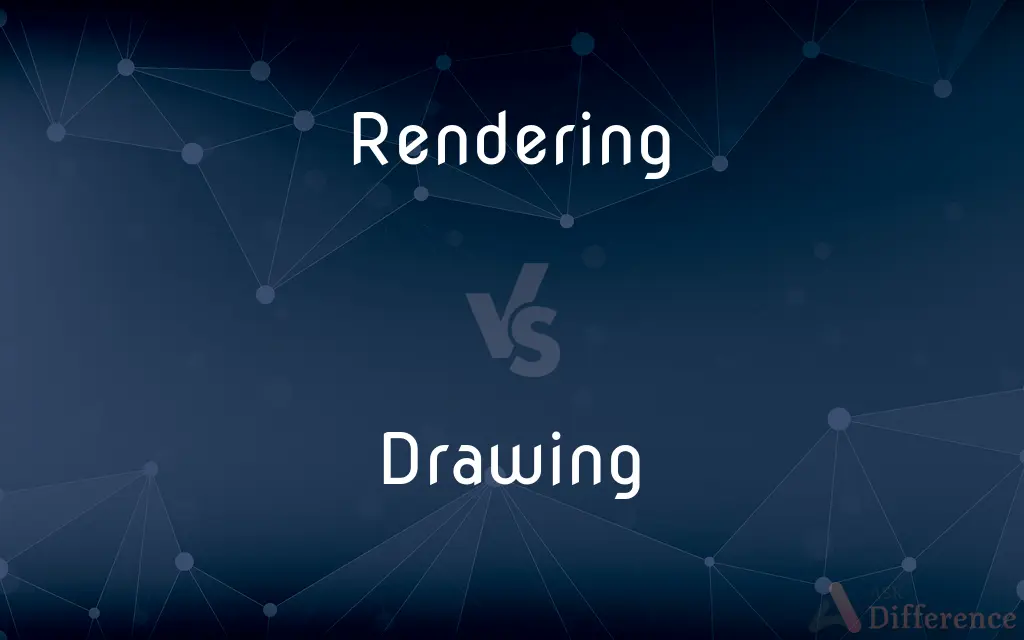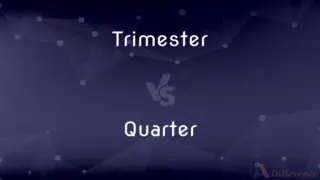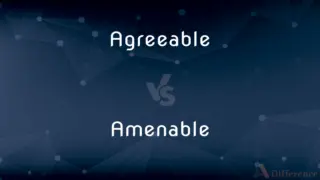Rendering vs. Drawing — What's the Difference?
By Maham Liaqat & Urooj Arif — Updated on March 14, 2024
Rendering is the process of generating a photorealistic or non-photorealistic image from a 2D or 3D model, while drawing involves creating images by making lines on a surface, often starting from scratch.

Difference Between Rendering and Drawing
Table of Contents
ADVERTISEMENT
Key Differences
Rendering is a complex process used in graphics to produce a final digital image from a model. It involves computer algorithms to simulate light behavior, textures, and materials to create realistic or stylized scenes. Whereas drawing is a fundamental art form involving the manual creation of images using tools like pencils, pens, or brushes, often relying on the artist's skill and imagination without the aid of computer algorithms.
In rendering, the focus is on achieving visual realism or a specific artistic style through computational methods. This can include the use of shading, lighting effects, and color theory to mimic real-world properties. On the other hand, drawing emphasizes the artist's ability to portray subjects using lines and shading, which can range from simplistic sketches to highly detailed illustrations.
Renderings are predominantly used in fields such as animation, architecture, and video game design, where detailed visualizations of scenes or objects are necessary. Drawing, however, finds its applications more broadly in art, design, engineering, and entertainment, serving both as a fundamental skill for conceptualizing ideas and as a form of artistic expression.
While rendering often requires a detailed 3D model and specialized software (like Blender or Autodesk Maya) to produce the final image, drawing can be done with minimal materials, such as paper and a pencil. This distinction highlights the accessibility and immediacy of drawing compared to the technical complexity and computational requirements of rendering.
The output of rendering is typically a digital image or animation that can be extremely detailed and photorealistic, making it ideal for simulations, visual effects, and virtual reality. Drawing outputs, while they can be digitized, originate in a physical or digital medium and can vary widely in style, from abstract to hyper-realistic, reflecting the unique hand of the artist.
ADVERTISEMENT
Comparison Chart
Definition
Creating a visual image from a model using computer algorithms.
Manual creation of images using lines and marks.
Tools
3D modeling software, computers.
Pencils, pens, brushes, digital tablets.
Applications
Animation, architecture, video games.
Art, design, engineering, conceptual sketches.
Focus
Realism or specific stylization through computation.
Artist’s skill in portraying subjects.
Output
Digital images, animations.
Physical or digital images.
Skills Required
Technical proficiency in software, understanding of light and material simulation.
Artistic skills, understanding of form and perspective.
Accessibility
Requires access to specialized software and hardware.
Minimal materials needed, more universally accessible.
Visual Characteristics
Can achieve photorealism or specific artistic styles.
Wide range in style, from abstract to hyper-realistic.
Compare with Definitions
Rendering
The process of generating a photorealistic or non-photorealistic image from a 2D or 3D model.
The architectural rendering beautifully showcased the planned building.
Drawing
The art or technique of producing images on a surface.
His talent for drawing was evident even in his early sketches.
Rendering
Producing images using computer algorithms.
The latest software allows for faster rendering of animations.
Drawing
Sketching as a form of artistic expression.
The artist’s drawing captured the emotion of the scene perfectly.
Rendering
Generating visual output from computer models.
Rendering technology has significantly improved in realism over the years.
Drawing
Creating pictures with pencils, pens, or other tools.
She spends her evenings drawing portraits.
Rendering
In graphics, the act of adding textures, lighting, and shading to a model.
Rendering the scene took several hours due to its complexity.
Drawing
The process of conceptualizing ideas through visual means.
Engineers use drawing to visualize their designs.
Rendering
The final stage in computer graphics production.
After modeling and animation, rendering brings the project to life.
Drawing
The act of making lines and marks to represent something.
Drawing has always been a fundamental skill for artists.
Rendering
A depiction or interpretation, as in painting or music.
Drawing
Drawing is a form of visual art in which an artist uses instruments to mark paper or other two-dimensional surface. Drawing instruments include graphite pencils, pen and ink, various kinds of paints, inked brushes, colored pencils, crayons, charcoal, chalk, pastels, erasers, markers, styluses, and metals (such as silverpoint).
Rendering
A drawing in perspective of a proposed structure.
Drawing
The act or an instance of drawing.
Rendering
A translation
A rendering of Cicero's treatises into English.
Drawing
The art of representing objects or forms on a surface chiefly by means of lines.
Rendering
A coat of plaster or cement applied to a masonry surface.
Drawing
A work produced by this art.
Rendering
The act or process by which something is rendered.
Drawing
Present participle of draw
Rendering
Version; translation.
Drawing
A picture, likeness, diagram or representation, usually drawn on paper.
Rendering
Sketch, illustration, or painting.
Drawing
The act of producing such a picture.
Rendering
(computer graphics) The process of producing an image from an internal model, or the image thus produced.
Drawing
Such acts practiced as a graphic art form.
Rendering
Present participle of render
Drawing
The process of drawing or pulling something.
Proverb: An official is great in his office as a well is rich in drawings of water.
Rendering
The act of one who renders, or that which is rendered.
Drawing
An act or event in which the outcome (e.g., designating a winner) is selected by chance in the form of a blind draw, notably of lots; especially such a contest in which a winning name or number is selected randomly by removing (or drawing) it from a container, popularly a hat.
Rendering
A performance of a musical composition or a dramatic role etc.;
They heard a live rendition of three pieces by Schubert
Drawing
A small portion of tea for steeping.
Rendering
An explanation of something that is not immediately obvious;
The edict was subject to many interpretations
He annoyed us with his interpreting of parables
Often imitations are extended to provide a more accurate rendition of the child's intended meaning
Drawing
The act of pulling, or attracting.
Rendering
The act of interpreting something as expressed in an artistic performance;
Her rendition of Milton's verse was extraordinarily moving
Drawing
The act or the art of representing any object by means of lines and shades; especially, such a representation when in one color, or in tints used not to represent the colors of natural objects, but for effect only, and produced with hard material such as pencil, chalk, etc.; delineation; also, the figure or representation drawn.
Rendering
A written communication in a second language having the same meaning as the written communication in a first language
Drawing
The process of stretching or spreading metals as by hammering, or, as in forming wire from rods or tubes and cups from sheet metal, by pulling them through dies.
Rendering
A coat of stucco applied to a masonry wall
Drawing
The process of pulling out and elongating the sliver from the carding machine, by revolving rollers, to prepare it for spinning.
Rendering
Perspective drawing of an architect's design
Drawing
The distribution of prizes and blanks in a lottery.
Rendering
Giving in acknowledgment of obligation
Drawing
An illustration that is drawn by hand and published in a book or magazine;
It is shown by the drawing in Fig. 7
Drawing
A representation of forms or objects on a surface by means of lines;
Drawings of abstract forms
He did complicated pen-and-ink drawings like medieval miniatures
Drawing
The creation of artistic drawings;
He learned drawing from his father
Drawing
Players buy (or are given) chances and prizes are distributed according to the drawing of lots
Drawing
Act of getting or draining something such as electricity or a liquid from a source;
The drawing of water from the well
Drawing
The act of moving a load by drawing or pulling
Common Curiosities
What is drawing?
Drawing is the manual process of creating images by making lines and marks on a surface, utilizing tools like pencils and pens.
Can drawing skills benefit someone learning rendering?
Yes, foundational drawing skills can enhance understanding of form, perspective, and composition, beneficial in 3D modeling and rendering.
What is rendering?
Rendering is the process of creating a visual image from a model through computer algorithms, focusing on realism or specific artistic styles.
Which is more accessible, rendering or drawing?
Drawing is more accessible due to its minimal material requirements, while rendering needs specialized software and hardware.
Is drawing only for traditional art?
No, drawing is fundamental across various fields, including art, design, and engineering, for conceptualizing ideas and artistic expression.
How do rendering and drawing contribute to the creation of video games?
In video games, rendering brings the game world to life with detailed environments and characters, while drawing is crucial for concept art and initial designs.
How do rendering and drawing differ in their tools and techniques?
Rendering requires specialized software and computers to simulate light and textures, while drawing uses simple tools like pencils and paper.
What are the primary applications of rendering?
Rendering is widely used in animation, architecture, and video game design for creating detailed visualizations and simulations.
Can renderings be considered a form of art?
Yes, renderings can be highly artistic, especially when they aim for stylization rather than strict photorealism.
Can digital drawing be considered a bridge between traditional drawing and rendering?
Yes, digital drawing can serve as a bridge, incorporating elements of both traditional drawing skills and digital techniques used in rendering.
How do the outputs of rendering and drawing differ?
Rendering typically results in digital images or animations, often photorealistic, whereas drawing produces physical or digital images reflecting the artist's style.
What makes drawing a versatile skill?
Drawing's versatility comes from its wide application across different fields and its ability to convey ideas and emotions through simple means.
What role does creativity play in both rendering and drawing?
Creativity is fundamental in both, guiding the artistic vision in drawing and influencing the aesthetic choices and problem-solving in rendering.
How has rendering technology evolved?
Rendering technology has evolved to produce more realistic and faster outputs, benefiting from advancements in computing power and software.
Why is rendering considered complex?
Rendering is complex due to its reliance on computational algorithms to simulate realistic lighting, textures, and materials.
Share Your Discovery

Previous Comparison
Trimester vs. Quarter
Next Comparison
Agreeable vs. AmenableAuthor Spotlight
Written by
Maham LiaqatCo-written by
Urooj ArifUrooj is a skilled content writer at Ask Difference, known for her exceptional ability to simplify complex topics into engaging and informative content. With a passion for research and a flair for clear, concise writing, she consistently delivers articles that resonate with our diverse audience.
















































